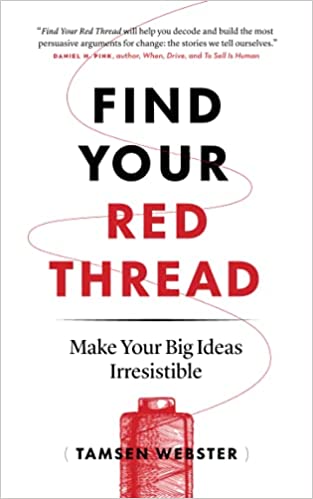“Find Your Red Thread” is the best book you’ll ever read on ideas and impact

If you are seeking to create influence and change with an original idea, you must read Tamsen Webster’s Find Your Red Thread: Make Your Big Ideas Irresistible. It’s short, it’s actionable, and it’s brilliant.
Here’s how to know if this book is for you: You have an idea and you want to spread it as broadly as possible. You could be an author, a public speaker, or somebody selling a new kind of product — but you’ve had a breakthrough and now you want attract people to your idea.
Find Your Red Thread is nothing less than a manual on how to do that.
This is much harder than it looks. For one thing, what is an idea? And how do you describe it in terms that will hook people? That is a very broad question. I don’t blame you if you are skeptical. As an editor and coach who works with authors, I deal with people in this situation all the time — and believe me, not only don’t they know where to start, they often don’t even realize that carefully defining their idea is a task worth doing.
Webster refined her thinking on this as an executive producer of TEDxCambridge, a position in which she evaluated and coached many dozens of people who imagined they had ideas, but those ideas weren’t quite there yet. This was the crucible in which her concepts about ideas formed.
The reason this book impressed me is because it takes on the hard problem of defining ideas and breaks it down into tractable pieces.
The problem with ideas
Here is what Webster says about ideas:
An idea is an answer, your answer, to a question that doesn’t already have an answer or that needs a better one. . . . [But] over and over again, great, important ideas never make it out of their creators’ heads. The ideas die the moment people have to explain them to an audience. Why? Because it’s not enough to have an idea, even if it’s great.
Central to this is that an idea is not what you believe it is. It is the story of change people tell themselves. What matters is how that idea looks once it’s inside of their heads. If that is inspiring, you win. If it fails to inspire, you’re just bloviating.
How to build your red thread
Here are the steps in creating a fully structured idea in Tamsen Webster’s red thread world:
- Define a goal — something that nearly everyone in your audience wants.
- Introduce a problem that people don’t know they have.
- Discover a truth that makes inaction impossible, because it puts the goal in jeopardy.
- Define the change they will make as a result of that truth.
- Turn the change into action that accomplishes the goal . . . and does much more, too.
These answers, taken together, generate a story.
How do you apply this? I wanted to see how it worked, so after reading the book, I attempted to apply it to my own work with authors. Here is a first draft of the result.
We can all agree we want to be recognized for our work. Despite the flood of ideas in the world, we want to believe that we can make an impact by sharing our knowledge. We can agree that nonfiction books, if crafted well, can help people. That’s why, to achieve the recognition we crave, we need to reimagine our ideas in ways that can energize and help readers to generate their own successes. That demands defining our ideas better, creating urgency, assembling concepts into a rational story, developing powerful case studies, and embracing the right publishing and promotion models. That not only creates the recognition we crave, it transforms ordinary humans into authors and generates positive change that moves the world forward.
Can you do this for your idea? Buy the book and find out.
Just simple enough
Does Webster’s framework seem simple? It is.
Is it simply to apply? It is not.
I found myself highlighting insights on about half the pages in this little book that reveal the tricks when it comes to defining these red thread elements.
For example, Webster notes that the problem is best formulated as a “two-part problem” — highlighting parts of reality that are in conflict: “a pair of words or short phrases that complement each other and/or have a relationship that the audience would readily acknowledge and understand.” (For example, “Despite the flood of ideas in the world, we want to believe that we can make an impact by sharing our knowledge.”)
Here’s another insight: “You can’t create change in someone else, only the conditions for it. Change comes from choice; choice comes from conflict.”
And this about your truth statement: “It’s often a belief, value, or assumption that is so core to who you are — it just seems so obvious to you — that it never occurs to you to articulate it.
Ideas are squishy. Grabbing onto them is like eel-wrestling. Just when you think you are close, you feel you are far away.
Until I read this book, my concepts about wrestling with ideas were all intuitive. They were based on experience. I could help people to move forward, but we were winging it.
Now there is a manual for that sort of thing.
If you want your ideas to make an impact, reading Find Your Red Thread and applying it could well be the most effective thing you can possibly do.